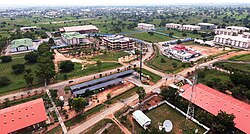Adamawa State
Lesdi Adamaawa (Adamawa Fulfulde) | |
|---|---|
| Names transcription(s) | |
| • Fulfulde | لٜسْدِ عَدَمَاوَ 𞤤𞤫𞤧𞤣𞤭 𞤢𞤣𞤢𞤥𞤢𞥄𞤱𞤢 |
 | |
| Nicknames: | |
 Location of Adamawa State in Nigeria | |
| Coordinates: 9°20′N 12°30′E / 9.333°N 12.500°E | |
| Country | |
| Established | 27 August 1991 |
| Named for | Modibbo Adama |
| Capital | Yola |
| Government | |
| • Body | Government of Adamawa State |
| • Governor | Ahmadu Umaru Fintiri (PDP) |
| • Deputy Governor | Kaletapwa Farauta (PDP) |
| • Legislature | State House of Assembly |
| • Speaker of State Assembly | Wesley Bathiya (PDP) |
| • National Assembly delegation | Senators: N: Amos Yohanna (PDP) C: Aminu Iya Abbas(PDP) S: Binos Dauda Yaroe (PDP) Representatives: List |
| Area | |
• Total | 36,917 km2 (14,254 sq mi) |
| Highest elevation | 2,042 m (6,699 ft) |
| Population (2006) | |
• Total | 3,178,950 |
• Estimate (2022) | 4,902,100[1] |
| • Density | 86/km2 (220/sq mi) |
| Time zone | UTC+1 (GMT) |
| Postal code | 640001 |
| Dialing Code | +234 |
| Geocode | NG-AD |
| GDP (2021) | ₦2.66 trillion[2] |
| HDI (2022) | 0.539[3] low · 25th of 37 |
| Website | www.adamawastate.gov.ng |
Adamawa State is a state in the North-East geopolitical zone of Nigeria, bordered by Borno to the northwest, Gombe to the west, and Taraba to the southwest while its eastern border forms part of the national border with Cameroon. It takes its name from the historic emirate of Adamawa, with the emirate's old capital of Yola serving as the capital city of Adamawa State. The state was formed in 1991 when the former Gongola State was broken up into Adamawa and Taraba states.[4] The state is one of the most heterogeneous in Nigeria, having over 100 indigenous ethnic groups.
Of the 36 states, Adamawa is the eighth largest in the area, but the thirteenth least populous with an estimated population of about 4.25 million as of 2016.[5] Geographically, the state is mainly composed of highlands and mountains (the Atlantika, Mandara, and the Shebshi ranges) and the Adamawa Plateau crossed by valleys and rivers, most notably the Benue and Gongola rivers. The lowlands of Adamawa are part of the West Sudanian savanna in the north and the wetter Guinean forest-savanna mosaic in parts of the south, while elevated areas are parts of the Mandara Plateau mosaic and Cameroonian Highlands forests ecoregions. In the extreme south of the state is part of the Gashaka Gumti National Park, a large wildlife park that contains large populations of bushbuck, African buffalo, patas monkey, black-and-white colobus, giant pangolin, and hippopotamus along with some of Nigeria's last remaining Nigeria-Cameroon chimpanzee, African leopard, and African golden cat populations.[6][7]
What is now known as Adamawa state has been inhabited for years by various ethnic groups, including the Bwatiye (Bachama), Bali, Bata (Gbwata), Gudu, Mbula-Bwazza, and Nungurab (Lunguda) in the central region; the Kamwe in the north and central region; the Jibu in the far south; the Kilba, Mafa, Marghi, and Waga in the north, and the Mumuye in the south while the Fulani live throughout the state — often as nomadic herders. Adamawa is also religiously diverse as about 50% of the population is Sunni Muslim and 40% is Christian (mainly Lutheran, EYN, ECWA, and Pentecostal), while the remaining 10% are adherents of traditional ethnic religions.[8][9]
As an agriculturally-based state, the Adamawa State economy mainly relies on livestock and crops, such as cotton, groundnuts, millet, cassava, guinea corn, and yams. Due to the Boko Haram insurgency affecting development in the state,[10] Adamawa has the eleventh lowest Human Development Index in the country but as the insurgency has abated since 2016 due to terrorist infighting,[11] development has been renewed.[3][12]
- ^ "Adamawa State: Subdivision". www.citypopulation.de.
- ^ "States of States 2022 Edition" (PDF). Archived from the original on 31 March 2023. Retrieved 19 March 2023.
{{cite web}}: CS1 maint: bot: original URL status unknown (link) - ^ a b "Human Development Indices". Global Data Lab. Retrieved 15 December 2021.
- ^ "This is how the 36 states were created". Pulse.ng. 24 October 2017. Retrieved 15 December 2021.
- ^ "Population 2006-2016". National Bureau of Statistics. Retrieved 14 December 2021.
- ^ Sani Kona, Lawal (20 January 2016). "Photos: Can helping local people save an embattled Nigerian park?". Mongabay. Retrieved 15 December 2021.
- ^ Briggs, Helen (23 February 2018). "Wildlife secrets of Nigeria's last wilderness". BBC News. Retrieved 15 December 2021.
- ^ Roelofs, Portia (November 2017). "Civil Society, Religion and the State: Mapping of Borno and Adamawa" (PDF). Abuja: Deutsche Gesellschaft für Internationale Zusammenarbeit. Retrieved 18 January 2022.
- ^ Nwankwo, Cletus Famous (27 March 2019). "Religion and Voter Choice Homogeneity in the Nigerian Presidential Elections of the Fourth Republic". Statistics, Politics and Policy. 10: 1–25. doi:10.1515/spp-2018-0010. S2CID 159290972. Retrieved 19 January 2022.
- ^ "Nigeria declares 'massive' military campaign on borders". BBC News. 15 May 2013. Retrieved 6 June 2013.
- ^ Al-Tamimi, Aymenn Jawad (5 August 2018). "The Islamic State West Africa Province vs. Abu Bakr Shekau: Full Text, Translation and Analysis". Archived from the original on 17 August 2018. Retrieved 17 August 2018.
- ^ "Celebrating the Return of Peace in Nigeria's Adamawa State". USAID. 12 July 2021. Archived from the original on 15 December 2021. Retrieved 15 December 2021.

